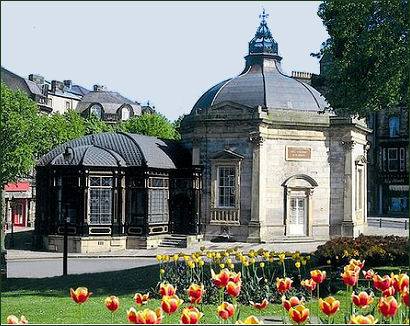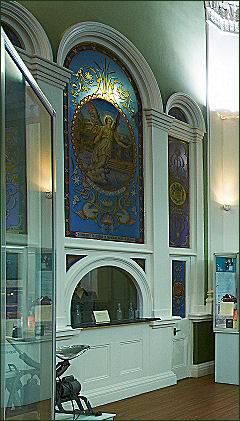Royal Pump Room, Harrogate
OS grid reference:-
 The Royal Pump Room, stands over Harrogate's main mineral spring, Europe's strongest sulphur well,a Grade II listed building, it is located in Crown Place in the western part of Harrogate town centre, opposite the town's Valley Gardens park.
The Royal Pump Room, stands over Harrogate's main mineral spring, Europe's strongest sulphur well,a Grade II listed building, it is located in Crown Place in the western part of Harrogate town centre, opposite the town's Valley Gardens park.
 The octagonal colonnaded stone Pump Room was constructed by Isaac Shutt in 1842, the project is said to have costed £2,249 and 7 shillings. It was built to provide shelter for the town's affluent visitors as they took the famous waters, where they could drink sulphur water which was pumped on site from a natural spring known as the Old Sulphur Well.
The octagonal colonnaded stone Pump Room was constructed by Isaac Shutt in 1842, the project is said to have costed £2,249 and 7 shillings. It was built to provide shelter for the town's affluent visitors as they took the famous waters, where they could drink sulphur water which was pumped on site from a natural spring known as the Old Sulphur Well.
Harrogate's first mineral spring was discovered in 1571 by William Slingsby, who claimed that water from the Tewit Well possessed curative properties. The Sulphur Well was discovered in the seventeenth century. The different waters of Harrogate's springs were recommended for the treatment of a variety of ailments including scurvy, epilepsy and skin complaints such as ulcers and sores.
At its peak, each summer the Pump Room attracted 15,000 people. Among its most famous visitors was Tsarina Alexandra of Russia, wife of Tsar Nicholas II and granddaughter of Queen Victoria, who visited in 1911 and the Victorian author Charles Dickens in 1858, who signed the visitors book. The Harrogate Improvement Commissioners Board's 1841 Harrogate Act established the principle that the poor should not be excluded from the perceived medicinal benefits of Harrogate's sulphur water. In order to conform to the act the Pump Room provided an outside tap which anyone could use. This tapcan still be seen today and it still works, however, it is not recommended to try the water, due to the health risks involved.
By the 1900's, the Royal Pump Room was experiencing overcrowding on a regular basis. The glazed annexe was added in 1913 to cater for the expanding visitor numbers. Designed by the architect Leonard Clarke, it now houses the permanent exhibition and the museum shop. The Pump Room attracted fewer visitors after the Second World War and with the emergence of the National Health Service the 'curing' waters were not taken as frequently and eventually the doors were closed.
On May 22nd 1953 the Royal Pump Room was reopened as a museum. The majority of the museum tells the story of Harrogate as a spa and a centre for rest and recuperation. The museum also regularly displays a selection of period costumes from its sizeable and historically significant collection of clothing. Recently a number of glass Hamilton style bottle, often known as 'torpedo' bottles - which all bare the inscription "bottled at the Royal Pump Room, Harrogate", were donated to the museum. Very few of these unusually shaped Victorian bottles have survived. They now form part of the display of the Pump Room's bottling room.
The museum is operated by Harrogate Museums and Arts, Harrogate Borough Council. The museum has a changing temporary exhibition programme and permanent displays of Harrogate's spa-history.
